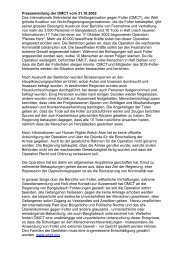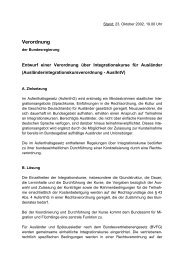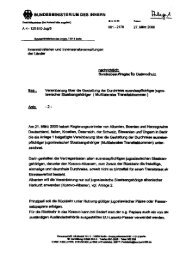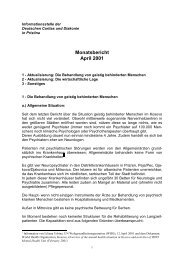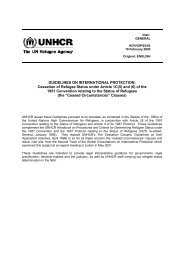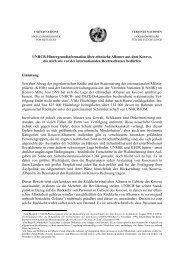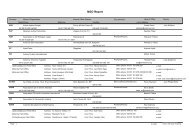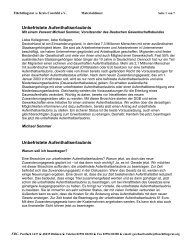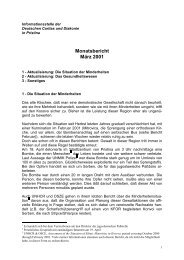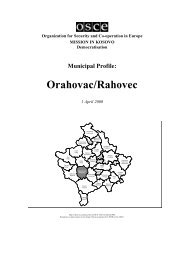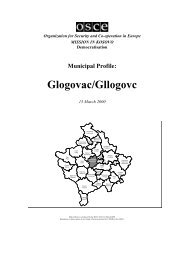Dragas/Dragash
Dragas/Dragash
Dragas/Dragash
Create successful ePaper yourself
Turn your PDF publications into a flip-book with our unique Google optimized e-Paper software.
Organization for Security and Co-operation in Europe<br />
MISSION IN KOSOVO<br />
Democratisation<br />
Municipal Profile:<br />
<strong>Dragas</strong>/<strong>Dragas</strong>h<br />
Pec<br />
Peje<br />
Decani<br />
Decan<br />
Djakovica<br />
Gjakove<br />
Istok<br />
Istog<br />
29 March 2000<br />
Zubin Potok<br />
Zubin Potok<br />
Klina<br />
Kline<br />
Orahovac<br />
Rahovec<br />
Prizren<br />
Prizren<br />
GORA<br />
DRAGASHI<br />
Leposavic<br />
Leposaviq<br />
Zvecan<br />
Zvecan<br />
Srbica<br />
Skenderaj<br />
Glogovac<br />
Kosovo Polje<br />
Gllogoc<br />
Fushe Kosove<br />
Suva Reka<br />
Suhareke<br />
Kosovska<br />
Mitrovica<br />
Mitrovice<br />
Vucitrn<br />
Vushtrri<br />
Obilic<br />
Obiliq<br />
Stimlje<br />
Shtime<br />
Strpce<br />
Shterpce<br />
Podujevo<br />
Podujeve<br />
Lipljan<br />
Lipjan<br />
Urosevac<br />
Ferizaj<br />
Pristina<br />
Prishtine<br />
Kacanik<br />
Kacaniku<br />
Novo Brdo<br />
Novo Berde<br />
Vitina<br />
Viti<br />
Gnjilane<br />
Gjilani<br />
Kosovska<br />
Kamenica<br />
Kamenica<br />
Map of Kosovo, produced by the HCIC GIS Unit March 2000.<br />
Boundaries or place names do not imply official recognition by UNMIK or the OSCE.
Table of Contents<br />
1. Introduction..........................................................................................................3<br />
Table 1.1: Ethnic Composition, Including IDPs.............................................................................. 3<br />
2. Civil Administration ............................................................................................4<br />
Table 2.1: UN-Appointed Municipal Council ................................................................................. 4<br />
Table 2.2: UN-Appointed Municipal Administrative Board ............................................................ 4<br />
3. Political Parties.....................................................................................................5<br />
Table 3.1: Political Parties ............................................................................................................. 5<br />
4. Local and International NGOs ............................................................................5<br />
Table 4.1: Local NGOs working in the municipality....................................................................... 5<br />
Table 4.2: International NGOs working in the municipality ............................................................ 6<br />
5. Other Civilian International Presence.................................................................6<br />
Table 5.1: The Four Pillars............................................................................................................. 6<br />
Table 5.2: Other International Organisations and Agencies............................................................. 6<br />
6. Religion, Places of Worship, and Cultural Institutions ......................................6<br />
Table 6.1: Main Religious Leaders................................................................................................. 6<br />
Table 6.2: Major Mosques, Churches, etc....................................................................................... 7<br />
7. Media....................................................................................................................7<br />
Table 7.1: List of Major Newspaper, TV/Radio Stations, etc........................................................... 7<br />
8. Judicial System.....................................................................................................7<br />
Table 8.1: List of Judges ................................................................................................................ 7<br />
9. Police, Civil Protection, and Military Presence...................................................8<br />
Table 9.1: Police and Military Presence.......................................................................................... 8<br />
10. Economics...........................................................................................................8<br />
10.1 Major Employers in the Region.............................................................................................. 8<br />
11. Infrastructure.....................................................................................................9<br />
12. Social Services, Health, and Education ............................................................9<br />
Appendix: Map of the Municipality<br />
This document may be multiplied and freely circulated,<br />
but should not be quoted without stating the source.<br />
2
1. Introduction<br />
<strong>Dragas</strong>/<strong>Dragas</strong>h municipality is located in the southernmost part of Kosovo, approximately 22<br />
km Southwest of Prizren. It borders the municipality of Prizren in the North as well as<br />
Albania in the West and the Former Yugoslav Republic of Macedonia in the South and East.<br />
The mountain ranges in the west, south and east reach altitudes of more than 2500 meters<br />
above sea level. The municipal capital <strong>Dragas</strong>(h) is situated at an altitude of 1050 meters.<br />
From the municipal capital there is a main road to Prizren (36 km) and roads to the towns of<br />
Restelica (24 km) and Brod (12 km). In winter times, Restelica, Brod, Zapluxhe and Plajnik<br />
(and the villages along these two roads) are very difficult to reach.<br />
<strong>Dragas</strong>(h) municipality covers an area of 434 sq. km and contains 36 villages. The<br />
municipality consists of two regions, the Gora area, which covers most of the municipality<br />
and is inhabited mainly by Goranis, and the Opoja area, which is located in the Northeast of<br />
the municipality and is mainly inhabited by Kosovo Albanians. 1 <strong>Dragas</strong>(h) town serves as the<br />
cultural and administrative centre for both Gora and Opoja.<br />
The population of the municipality is about 35,000, with 84 inhabitants per sq. km and the<br />
highest birth rate in Kosovo. 2 About two-thirds of the municipal population is Kosovo<br />
Albanian and one third is Gorani. In general the Gorani community defines its language as<br />
‘Goranian’, which is a mixture of Macedonian, Turkish, Bosnian, and Serbian. Some<br />
villages, however, prefer to define their language as ‘Bosnian’, ‘Serbian’, or ‘Nasinski’<br />
(which means ‘our language’) depending on political preferences.<br />
There has always been a fluctuation of the population as the men left for economical reasons<br />
while their families stayed behind. Today most men live with their families, especially in the<br />
Gora area. Both Gora and Opoja are almost entirely 'ethnically pure' (Goranis vs. Kosovo<br />
Albanians), although the population in the centre of <strong>Dragas</strong>(h) is ethnically mixed.<br />
Table 1.1: Ethnic Composition, Including IDPs 3<br />
Population K-Albanians Goranis Total<br />
Number % Number % Number %<br />
1991 22.802 59% 16.112 41% 38.914 100%<br />
March 1999 27.633 61% 17.470 39% 45.103 100%<br />
May 1999 25.383 67% 12.386 33% 37.769 100%<br />
March 2000 24.856 72% 9.706 28% 34.562 100%<br />
Source: For 1991: Census data, Federal Office of Statistics in Serbia, For March 1999: UNHCR Kosovo Village List,<br />
For May 1999: Administration Department of the Municipality of <strong>Dragas</strong>(h), for March 2000: OSCE Field Office <strong>Dragas</strong>(h)<br />
for Gora side, CRS statistics for Opoja side.<br />
The table displays the large outflow of Goranis from the area since 1991, and especially since<br />
the end of the war. This is mainly due to security concerns, since Goranis have been accused<br />
by Kosovo Albanians of siding with the Kosovo Serbs, and to economic concerns, partly<br />
related to the lack of freedom of movement that results from the Gorani’s security situation.<br />
Finally, a small number of refugees from Bosnia (about 100 families) reside within the Gora<br />
area, although there is no significant presence of Internally Displaced People (IDPs) in the<br />
municipality.<br />
1 This report is based on the pre-1991 boundaries, which are expected to be accepted as the official<br />
boundaries by UNMIK in the very near future. <strong>Dragas</strong>(h) was in 1991 divided by Yugoslav<br />
authorities, who included the Opoja region within Prizren municipality, and named the remainder 'Gora<br />
Municipality'.<br />
2 Regional Bureau of Statistics 1982:14<br />
3 Please note that these numbers are subject to change and drawn on different sources.<br />
3
2. Civil Administration<br />
The Municipal Council was inaugurated on 9 th February 2000. Within this political body<br />
Goranis have obtained five seats out of 16. The Kosovo Albanians are mainly represented by<br />
Hashim Thaci's Party of Democratic Progress in Kosovo (PPDK) and Ibrahim Rugova's<br />
Democratic League of Kosovo (LDK).<br />
Table 2.1: UN-Appointed Municipal Council 4<br />
Name Function Party-affiliation Ethnicity/Nationality<br />
Marek Kasprzyk UN Municipal Administrator none Polish<br />
Sadik Idrizi Member of Executive Board of SDA <strong>Dragas</strong>(h) SDA Gorani<br />
Mushka Fazlian President of SDA <strong>Dragas</strong>(h) SDA Gorani<br />
Nihad Osmani Member of Executive Board of SDA <strong>Dragas</strong>(h) SDA Gorani<br />
Mitat Fejza President of PPDK <strong>Dragas</strong>(h) PPDK Kosovo Albanian (KA)<br />
Ibrahim Skenderi Member PPDK KA<br />
Refki Skenderi Member PPDK KA<br />
Halim Shemsidini Member LDK KA<br />
Shaban Halimi Member LDK KA<br />
Mehmet Spahiu Member LDK KA<br />
Fari Piraj Member LBD KA<br />
Alija Demiri Member DAS Gorani<br />
Vajdin Tahiri Member PBK KA<br />
Agim Rexhepi Islamic Community None KA<br />
Luljeta Kryeziu Women-Independent Candidate None KA<br />
Emina Kurteshi Women-Independent Candidate None KA<br />
Hamza Uzair Independent Candidate from Gora side (member of SDA) Gorani<br />
The Administrative Board in the Municipality was inaugurated on 26 th January 2000 and was<br />
given a temporary 90-day mandate. There are a total of nine directorates, all of which are<br />
chaired by Kosovo Albanians, which has led to dissatisfaction among the Gorani population.<br />
However, one Vice President of the Administrative Board is Gorani, representing the Party of<br />
Democratic Action (SDA). There is also dissatisfaction among some Kosovo Albanians,<br />
which complain about the dominance of PPDK on the Administrative Board.<br />
Table 2.2: UN-Appointed Municipal Administrative Board<br />
Name Function Party-affiliation Ethnicity/Nat.<br />
Marek Kasprzyk UN Municipal Administrator None Polish<br />
Hajriz Meleqi President of Administrative Board None officially KA<br />
Irfan Ibrahimi Vice President of Administrative Board SDA Gorani<br />
Nexhmidin Asllani Vice President of Administrative Board PPDK KA<br />
Beqir Rashiti Director of Gen. Adm., Budget, Transport, Post, and Communications None officially KA<br />
Avni Nebiu Director of Economy & Finance & Business &Commerce PPDK KA<br />
Nuriman Tershnjaku Director of Health & Social Welfare LBD KA<br />
Salajdin Tafili Director of Science & Culture & Youth & Sport LDK KA<br />
Muharem Sejrani Director of Education & Democratisation & Media Development PPDK KA<br />
Hasan Dishallari Director of Development & Planning & Environmental Protection PPDK KA<br />
Hyrjet Sinani Director of Urbanism & Communal Operations None Officially KA<br />
Mensur Halili Director of Geodesy & Cadastre PPDK KA<br />
Tafil Krasniqi Director of Civil Emergency & Relief PPDK KA<br />
The UN Civil Administration (UNCA) has folded most of the previous PPDK-dominated<br />
“self-styled” government structures into the new municipal structure that followed the 15<br />
December Agreement on a Kosovo-UNMIK Joint Interim Administrative Structure, which<br />
was agreed to on provincial level.<br />
4 See table 3.1 for an explanation of acronyms.<br />
4
3. Political Parties<br />
Although a multiparty political system is developing in <strong>Dragas</strong>(h), a post-war political culture<br />
is still present. Basic to this culture is a difficulty to stray from hard-line policies (e.g. ex-<br />
Socialist Party of Serbia (SPS) within Gora and National Conservative/Frontal Party of<br />
Kosovo (PBK) within Opoja side) as well as a persisting inability to critically examine one’s<br />
own society. To move away from established principles or openly to criticise policies or<br />
approaches could be viewed as betrayal.<br />
The LDK, which has been present also in <strong>Dragas</strong>(h) during the last decade as a national<br />
movement, holds some support among the Kosovo Albanian population, although the exact<br />
level of support is difficult to know until elections have been held. The PPDK established<br />
much support when it was dominating the former 'self-styled' municipal government, and still<br />
seems to hold some of this popularity. Among these two parties, the LDK seems to have the<br />
most support among the Kosovo Albanian population.<br />
The Gorani side is characterised by a lack of unity. Some Goranis support the Party of<br />
Democratic Action (SDA), which has its roots in the Muslim community of Bosnia and is<br />
focused largely on ensuring that the Bosnian language will be valid also in the future.<br />
Although there is support for the SDA in some villages, some people in other villages still<br />
support policies and political parties linked with current Belgrade politics, such as<br />
Milosevic’s Socialist Party of Serbia (SPS), and the opposition Serb Renewal Movement<br />
(SPO). There is a third group of Goranis that does not actively support any of the above<br />
parties but instead seems to be looking for another alternative.<br />
Table 3.1: Political Parties<br />
Party Regional Party Leader Kosovo-wide Leader<br />
LDK (Democratic League of Kosovo) Halim Shemsidini Ibrahim Rugova<br />
PPDK (Party of Democratic Progress in Kosovo) Mitat Fejza Hashim Thaqi<br />
LBD (United Democratic Movement) Nesim Miftari Rexhep Qosja<br />
PBK (National Conservative/Frontal Party of Kosovo) Xhevdet Tahiri (To be announced)<br />
SDA (Party of Democratic Action) Mushka Fazlian Numan Balic<br />
DAS (Democratic Amin Party) Alija Demiri Alija Demiri<br />
4. Local and International NGOs<br />
There are three local NGOs based in the municipality, two of which are humanitarian in<br />
nature (Mother Theresa Society and Handikos) and one of which focuses on women's issues<br />
(Flaqa). Handikos is especially concerned with the welfare of handicapped people in the<br />
municipality.<br />
Table 4.1: Local NGOs working in the municipality<br />
Name Main focus Regional Leader Kosovo-wide Leader<br />
Handikos Humanitarian Bexhet Xheladini Agim Terpuni -Prizren<br />
Mother Theresa Society Humanitarian Fadil Rashiti Don Lush Gjergji<br />
Flaqa Women’s progress Sabahete Kurtishi Sabahete Kurtishi<br />
The international NGOs working in <strong>Dragas</strong>(h) are mainly based in Prizren or Pristina, with<br />
the exception of the Balkan Peace Team that is in the process of opening its office.<br />
5
Table 4.2: International NGOs working in the municipality<br />
Name Main focus Authorised Representative<br />
CRS (Catholic Relief Service) Food distribution Kathleen Moynihan<br />
ACT (Action of Church Together) Humanitarian Hoyer Thorkild<br />
BPT (Balkan Peace Team) Peace building Alan Jones<br />
World Vision Psychosocial support Stuart Charles Willcuts<br />
MSF (Medecines Sans Frontiers) Medicine Phillippe Rosen<br />
MCIC(Macedonian Centre for International Co-operation) Humanitarian Aleksandar Krzalovski<br />
ICMC (International Catholic Migration Commission) Humanitarian Dale Buscher<br />
ICRC (International Committee of the Red Cross) Humanitarian Alain Koli<br />
Handicap International France Humanitarian Driton Ukmata<br />
PSF (Pharmacists Sans Frontiers) Medicine Bruno Rotival<br />
ICS (Italian Consortium of Solidarity) Educational Raffaella Bolini<br />
5. Other Civilian International Presence<br />
UN Civil Administration (UNCA), along with the UN Municipal Administrator, arrived in<br />
August 1999. There are currently three Municipal Officers and three United Nations<br />
Volunteers (UNVs) working for the UNCA.<br />
The OSCE field office became operational in October 1999 and currently consists of four<br />
international staff members and 21 local staff members. Though the UNHCR is covering<br />
<strong>Dragas</strong>(h) they are not based in the municipality, and the UNMIK 'EU pillar' is also not based<br />
in the municipality. However, the European Commission Monitoring Mission (ECMM),<br />
which is separate from the EU pillar, monitors the general situation in the municipality<br />
although it is not based there. Other organisations and agencies are also frequently in the<br />
area.<br />
Table 5.1: The Four Pillars<br />
Name Number of staff (nat.+int.) Contact Person Title Contact Number<br />
UN Civil Adm. 6 Internationals, 2 nationals Marek Kasprzyk UN Administrator N/A<br />
OSCE 4 Internationals , 21 Nationals Levan Gogoberidze HO Field Office 00871762138688<br />
UNHCR Not yet based in <strong>Dragas</strong>(h) - - -<br />
EU Not yet based in <strong>Dragas</strong>(h) - - -<br />
Table 5.2: Other International Organisations and Agencies<br />
Name Number of staff<br />
(nat.+int.)<br />
Contact Person Title Contact Number<br />
ECMM N/A Wolfgang Obermueller Team Leader 003812923933<br />
6. Religion, Places of Worship, and Cultural Institutions<br />
Both the Goranis and the Kosovo Albanians in the municipality are of the Islamic faith. Due<br />
to an insufficient number of imams, one Kosovo Albanian imam is based in a Gorani village<br />
(Brod). In <strong>Dragas</strong>(h) town the attendance at the mosque includes both ethnicities. It seems<br />
that the Islamic Community has managed to keep the two ethnic groups together despite the<br />
division at the political level. The imams are generally not actively engaged in current issues.<br />
Though the president of the Islamic Community is a member of the municipal council, there<br />
are no overt signs of political influence within the religious community.<br />
Table 6.1: Main Religious Leaders<br />
Name Religious Organisation<br />
Agim Rexhepi Islamic Community of <strong>Dragas</strong>(h)<br />
Nailj Halimi Islamic Community of <strong>Dragas</strong>(h)<br />
Dzafer Fejziu Islamic Community of <strong>Dragas</strong>(h)<br />
Source: Islamic Community of <strong>Dragas</strong>(h)<br />
6
There are 39 mosques in <strong>Dragas</strong>(h) municipality, none of which were destroyed during the<br />
war. There are about an equal number of mosques in the Gora and Opoja areas respectively.<br />
Table 6.2: Major Mosques, Churches, etc.<br />
Name and Place Type of Building (Mosque, Orth. Church… )<br />
<strong>Dragas</strong>(h) centre, 20 mosques in Gora, 19 in Opoja Mosques<br />
Source: Islamic Community of <strong>Dragas</strong>(h)<br />
The only existing cultural/community centre has been established by an Italian NGO within<br />
the Opoja area, and the Balkan Peace Team, another international NGO, is planning a<br />
cultural/community centre in <strong>Dragas</strong>(h) town. Otherwise, the process of reviving pre-war<br />
cultural institutions is still on-going. A literary club, ‘Luigi Gurakuqi’, is present in the Opoja<br />
area, but is not very active due to financial constraints.<br />
7. Media<br />
There are no local daily newspapers, although a periodical Kosovo Albanian newspaper,<br />
‘Sharri’, is produced by the literary club ‘Luigi Gurakuqi’. There are about six editions a year<br />
although the intention has been to have it be a monthly newspaper. No TV station exists.<br />
There is a local radio, also named ‘Sharri’, which is not working these days, since the<br />
transmitter is not functioning. Efforts are on-going towards solving the technical and<br />
ownership problems of the radio station, which used to have a one and one-half hour daily<br />
broadcast in the Goranian language. There are currently some signs that the PPDK is trying<br />
to control the radio station.<br />
There is only one correspondent in the municipality, who is based in the town of Shajne and<br />
writes for the Rilindja newspaper in Pristina.<br />
Table 7.1: List of Major Newspaper, TV/Radio Stations, etc.<br />
Name of media Type of Media Editor/Correspondent Ethnic Affiliation<br />
Radio Sharri Radio Director Chamil Kolloni Kosovo Albanian<br />
Rilindja Newspapers Correspondent Azbi Halili Kosovo Albanian<br />
8. Judicial System<br />
The Municipal Court and the Minor Offenses Court were put in place by UNMIK on 1 st<br />
January 2000 and all judges were given a mandate for one year. The letters of appointment<br />
were issued at an official ceremony held on 20 th January. Since January, the number of cases<br />
processed within the Municipal Court have been around 15-20.<br />
The volume of cases within the Minor Offences Court since January has been approximately<br />
50. There still seems to be some confusion with regard to the issuing of fines.<br />
When UNMIK police makes arrests, detainees are taken to Prizren to a regional jail.<br />
Table 8.1: List of Judges<br />
Name Title Ethnicity<br />
Sefidin Bajraktari President of Municipal Court Kosovo Albanian<br />
Naim Kurtishi Judge at the Municipal Court Kosovo Albanian<br />
Fahri Tershnjaku Judge at the Municipal Court Kosovo Albanian<br />
Hamed Ferati Judge at the Municipal Court Muslim – Prizren<br />
Beqri Vehapi Judge at the Minor Offences Court Kosovo Albanian<br />
Sabahete Kurtishi Judge at the Minor Offences Court Kosovo Albanian<br />
Source: Municipal Court in <strong>Dragas</strong>(h)<br />
7
9. Police, Civil Protection, and Military Presence<br />
A permanent Turkish KFOR checkpoint is located at the entry of <strong>Dragas</strong>(h) town. Random<br />
checks are made, causing little delay. Recurring manned roadblocks are enacted at the<br />
junction to the town of Brezna. Turkish KFOR is generally well respected in the community,<br />
but the number of soldiers has been reduced from 300-350 to 200. They have excellent cooperation<br />
with UNMIK Police, which is still regarded as being understaffed. Some shop<br />
owners still complain about being asked for ‘voluntary citizens contributions’ from members<br />
of the illegal Policia Ushtarake (Kosovo Liberation Army Police).<br />
The Kosovo Protection Corps (TMK), which plays an active role in the community, is based<br />
only in the Opoja side in the village of Zym, after having been requested by UN Civil Police<br />
and Turkish KFOR to leave <strong>Dragas</strong>(h) town.<br />
Table 9.1: Police and Military Presence<br />
Name Local Commander Number of Police Officers, Ethnic Composition,<br />
Soldiers, etc.<br />
Nationality<br />
KPS Gerhard Wittig – Station 1 Kosovo Albanian<br />
UN Civil Police<br />
Commander of UNMIK Police<br />
Gerhard Wittig 38 International<br />
TMK Ruzhdi Saramati 52 Kosovo Albanian<br />
KFOR Umit Oz 200 Turkish<br />
Source: KFOR, and UNMIK Police in <strong>Dragas</strong>(h)<br />
10. Economics<br />
The economic situation is dominated by a high unemployment rate. About 28% of employees<br />
within the local economy in the municipality are Goranis and about 72% are Kosovo<br />
Albanian. All major local companies were formerly state-run and UNMIK is currently<br />
resolving ownership issues through a ‘Commission of Entrepreneurs’, which was established<br />
by the Municipal Council. None of these companies are currently operating at full capacity.<br />
Dratex for instance, a textile manufacturer, had more than 600 employees in the early 1990’s,<br />
but currently employs only 86 people. Similarly, Shar Prodimi, a grocer’s chain and sheep<br />
breeding company, used to employ 230 people, but now only employs 62. The latter<br />
company has recently received 30,000 DM in financial support from UNMIK to help the<br />
company to recover from current difficulties. There are many smaller shops in the town of<br />
<strong>Dragas</strong>(h), but none have officially registered yet with the UN.<br />
All former state-owned enterprises have delivered business plans to UNMIK, which, through<br />
its pillar for Economic Reconstruction led by the European Union, hopes to revive the local<br />
economy. No income generating projects exist as of now, but UNMIK is aiming to<br />
implement micro-credit schemes in the municipality to support small-scale enterprises.<br />
10.1 Major Employers in the Region<br />
Employer Service/Products Production<br />
going?<br />
on Number of Workforce<br />
Dratex – state owned Textile Yes 86 (82 KA, 3 G, 1 S)<br />
Shar Prodimi – state owned Grocer’s chain/sheep<br />
breeding company<br />
Yes 62 (41 KA, 21 G)<br />
Koritnik - state owned Trade - Restaurants Yes 37 (21KA, 16 G)<br />
Economia Pyjore –state owned Forest company Yes 29 (18 KA, 11 G)<br />
Komunalno – state owned Public Utilities Yes 32 (25 KA, 7 G)<br />
Source: Department of Economy, Finance, Business, and Commerce in <strong>Dragas</strong>(h).<br />
8
11. Infrastructure<br />
The municipality is mountainous and therefore has infrastructure problems related to terrain,<br />
e.g. with regard to access. This part of Kosovo did not suffer much damage during the war<br />
and therefore most of the infrastructure is intact with the exception of a few damaged<br />
buildings. The urgent need in this municipality is not re-construction of infrastructure<br />
damaged by the war, but improving the existing infrastructure which is in a state of disrepair<br />
and inadequate for the population. The region has been suffering from permanent<br />
infrastructure problems for a long time, due to a low-investment policy and negligence.<br />
Opoja is an area with relatively small war damages. There are around 45 houses, which have<br />
been destroyed. These houses have mainly been rebuilt by the local population, with the help<br />
of an international NGO, Action of Churches Together (ACT), which provided reconstruction<br />
material. Electricity is supplied partly by a hydroelectric plant in Dikance.<br />
Travel between villages is still frequently by foot or horse-drawn wagon, and many roads in<br />
the municipality are not paved, especially in the Opoja region. A lack of bus connections to<br />
the villages contributes to the restricted movement, especially for Goranis. A 15-km trip by<br />
taxi costs 10-15 DM, which is unaffordable for most, especially those that have lost their<br />
source of income.<br />
Due to poor agricultural resources and relative geographical isolation, <strong>Dragas</strong>(h) has been one<br />
of the most underdeveloped regions of Kosovo.<br />
12. Social Services, Health, and Education<br />
UNMIK started an Emergency Assistance Financial Program last November to assist<br />
individuals falling under three categories: pensioners over 70, single parent households, and<br />
persons with disabilities. In total 657.000 DM has been paid to more than 2500 beneficiaries.<br />
A Centre for Social Welfare is expected to be opened on 8 th May 2000. The director of<br />
Centre for Social Welfare will be Mr. Zahadin Lekaj, an LDK member who was appointed by<br />
UNMIK on 29 th March 2000.<br />
The Health Centre in addition to its main building has 12 clinics (ambulantas) within both<br />
Opoja and Gora. These clinics generally have one paediatrician, two general practitioners, 2<br />
dentists, and some medical nurses. The director of the Health Centre, Mr. Fehmi Bojaxhiu, is<br />
a gynaecologist and belongs to LDK party. The total number of employees in the Health<br />
Centre and the clinics is 115, which includes 28 doctors (17 KA and 11 G) and 63 medical<br />
technician (47KA and 16 G) and 24 others (15 KA and 9G). Thus, the staff of the Health<br />
Centre and the clinics is about 69% Kosovo Albanian and 31% Gorani, which roughly<br />
corresponds to the two communities' share of the municipal population at the end of the war.<br />
The gender structure in the Health Centre and its clinics is 23 female and 92 male. Salaries<br />
are paid by UNMIK in the range of 150 – 600DM since January 2000. The main problems of<br />
the Health Centre include lack of an efficient salary system, lack of medicine, obsolete<br />
equipment, and lack of on-the-job training of its personnel. The German organisation Die<br />
Johaniter has donated one van to the Bresane clinic and renovated it completely, and help has<br />
also been received from the German KFOR, UNHCR, and Medicins Sans Frontieres (MSF).<br />
Though all villages now have their own elementary schools, which are attended by a total of<br />
5,424 students in 12 schools with 23 satellite branches, the only high school is in <strong>Dragas</strong>(h)<br />
town. The high school is ethnically mixed and the curriculum is in two languages (Albanian<br />
and Bosnian). The total number of students is 855. In terms of ethnic composition, there are<br />
9
about 85% Kosovo Albanian students and 15% Goranis. The gender situation is not very<br />
good, with 78% male students and 22% female students.<br />
The total number of employees within the educational system of <strong>Dragas</strong>(h) is 456, including<br />
59 high school teachers and 181 elementary school teachers (grade 5-8). The ethnic structure<br />
is 286 Kosovo Albanian (63%) and 170 (37%) Goranis. Salaries have been paid by UNMIK<br />
since January 2000. The salaries range from 150 – 390DM. The main issues of concern at the<br />
moment are the salaries, which are not always paid in a timely manner, and the fact that<br />
teachers often have to teach different educational levels within the same classroom, due to the<br />
small number of students in some remote villages.<br />
Source: UNCA <strong>Dragas</strong>(h), Municipality of <strong>Dragas</strong>(h), Department of Education, Media, and Democratisation, Department of<br />
Health and Social Service.<br />
10



